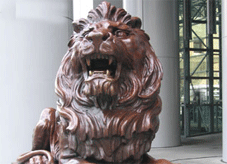HSBC Lions

Public Art: HSBC Lions
Also Known As: Stephen and Stitt
Sculptor: © William Wheatley Wagstaff (16th November 1880- 13th December 1962) but based on models by Henry Poole (28 January 1873 — 15 August 1928).
Cast In : Shanghai
Description: Two bronze lions guarding the HSBC (Hongkong and Shanghai Banking Corporation) building were cast from Henry Poole’s models. The two lions were nicknamed Stephen and Stitt after the Shanghai’s Chief Manager Alexander Stephen (and the man who came up with the idea) and Gordon Stitt the man who would later replace him as Chief Manager. Stephen is of course the roaring lion.
Date Unveiled: October 1935.
Location: The HSBC Lions are located outside the Hongkong and Shanghai Banking Corporation building at 1 Queen’s Road Central in Hong Kong.
The History Behind The HSBC lions: In the early 1920s the Chief Manager of the new Shanghai branch of HSBC, Alexander Stephen, visited Italy where he saw the stone lion outside the Arsenal gate in Venice. He was so impressed with the lion and the symbols of protection and courage that it represented he decided to order a pair for outside the new Shanghai branch in China. The lions were cast in London from models made by Henry Poole and then shipped to China in 1923 for the opening.
The Shanghai lions proved a such a big hit and a great symbol of prosperity and growth for the bank that when the new Hong Kong building was commissioned in the mid-1930s the Chief Manager, Sir Vandeleur Grayburn, ordered two bronze statues for the main entrance on Des Voeux Road. These lions were cast in Shanghai and took over two years to complete. The lions were cast in segments and then later joined together.
The Lions Disappear: During World War II, when the Japanese occupied Hong Kong, many of their statues were stolen and shipped back to Japan to be melted for scrap metal. Stephen and Stitt were amongst those stolen. Fortunately, an eagle-eyed American soldier noticed them at a Japanese naval dock in Osaka following the war. He had no idea that the lions were from Hong Kong but did remember seeing a similar pair outside the Shanghai office in China. He contacted HSBC and told them of his discovery. The bank then set about having them returned to their rightful spots in Hong Kong. The task was not as easy as it seemed, and if it wasn’t for General MacArthur, Supreme Commander of the occupying forces in Japan, ordering Stephen and Stitt to be shipped back, they may have never seen Hong Kong again.
In October 1946 Stephen, the roaring lion (left) and Stitt the quiet one (right) were placed back in their original positions. Despite being restored the two still bear the “shrapnel scars” of World War II. Stephen has bullet marks on his left hind quarter.
On the 18th of October 1946 the South China Morning Post reported:
“In the dead of last night the two bronze lions … crept back
to their pedestals and this morning looked as comfortable
and unconcerned as if they had never moved”.
Following their return not only did the bank begin to grow and prosper again but so did Hong Kong, reinforcing the myth that the lions were the protector of the city.
Things You May Not Know About the HSBC Lions:
The first lions were commissioned in 1923 for the HSBC Building in Shanghai. Designed by Henry Poole and cast by J W Singer & Sons in England. When the HSBC opened in Hong Kong two bronze lions were commissioned. They were based on Poole’s original design but arent identical.
The two lions were nicknamed Stephen and Stitt after the Shanghai’s Chief Manager Alexander Stephen (and the man who came up with the idea) and Gordon Stitt the man who would later replace him as Chief Manager. Stephen is, of course, the roaring lion.
The sculptor William Wheatley Wagstaff, who had a hunch-back was nicknamed “Lao Doo Pei”, meaning “Old Hunchback”.
In 1981 the lions were removed and placed in Statue Square for 4 years while the new HSBC headquarters was built. When they were moved to their new home on the 1st of June, 1985, a Fung Shui expert was brought in to supervise the event and both were carefully lifted simultaneously by two cranes to avoid giving one precedence over the other.
The paws of the lions are shiny from the thousands of people who have rubbed their feet over the years seeking good luck and good fortune.
In the base of each lion, there are buried 8 coins, a symbol of good luck in China tradition.
When the new global headquarters was built in Canary Wharf, London, exact copies of Stephen and Tritt statues were included in the design. Yes, they all have 8 coins buried in the base.
There are lions outside all HSBC buildings around the world.
There are numerous “fake” unauthorised HSBC Lions outside financial institutions.